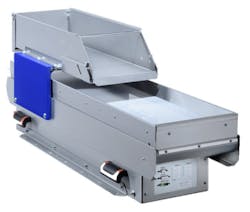The Rise of Flexible Feeding System Technology
When it comes to feeding individual parts into an assembly or packaging line, vibratory bowl feeders have long been the preferred method. Bowl feeders are known for their ability to consistently sort small parts in a particular direction for handling by another automated system or by humans in the assembly or packaging process.
One downside to bowl feeders is that they are designed to work with specific parts. This means that whenever a part is changed, the bowl feeder also needs to be changed to one designed for the new part. Doing so, of course, increases changeover time. Because of this lack of flexibility, a new trend in parts feeding is emerging that involves the integration of multiple automation technologies to create a flexible feeding system capable of performing the duties of a vibratory bowl feeder, but for many different part types.
Another issue with bowl feeders for many manufacturers is the additional noise they create. “Bowl feeders are constantly vibrating, so they make a lot of noise,” said Rick Tomaszewski, strategic account manager for Omron Automation America. This issue, in addition to the changeover time requirements, is leading more manufacturers to explore different part feeding methods.
Armo-Tool’s approach to flexible feeding
To help a Tier 1 automotive supplier address the speed and reliability issues it was facing with one of its bowl feeder systems, Armo Tool, a supplier of industrial tooling and automation based in London, Ontario, Canada, worked with Omron Automation and Taylor Fluid Systems, a local distributor, to develop a flexible feeding system using vision, motion, and robotics technologies.
Using Omron’s AnyFeeder flexible feeding system, along with rotary and linear servos, FH vision, e-Cobra SCARA robots, and a Sysmac controller, Armo Tool was able to create a new flexible feeding system for the automative supplier that delivered 99% efficiency at startup, versus 70% or less from the bowl feeder. In addition, changeover time was reduced to less than 10 minutes.
When combined with a vision-guided robot, Omron’s AnyFeeder provides flexible part feeding that “exceeds the capacity of hand-tooled bowl feeders,” said Tomaszewski. “Its flexibility in feeding small parts of various size, shape, and material, allow for fast line changeover and significantly reduced tooling costs.”
Tomaszewski noted that, in addition to reduced startup time, the new integrated system helps ensure the right part is selected every time. “For the plant manufacturing brake lines across multiple vehicle models, this is especially critical,” he said. “It’s imperative that the correct end-form fitting is attached to the correct brake line pipe. Affixing the wrong fitting could risk product recall and costly reviews.”
By using AnyFeeder, the automotive parts supplier can now run multiple fittings on the same end forming machine, according to Tomaszewski. “The solution incorporates poka-yoke, which guarantees they always run the right fitting onto the pipe or tube,” he said. (Poka-yoke refers to any mechanism in a lean manufacturing process that helps an equipment operator avoid mistakes. Its purpose is to eliminate product defects by preventing, correcting, or drawing attention to human errors as they occur.)
Benefits of vision integration
The use of Omron’s FH vision technology to guide pick and place actions performed by Omron’s e-Cobra 600 SCARA robots ensure accuracy, Tomaszewski said. The system uses vision to verify the correct part is selected, provide pickup coordinates from the randomly oriented parts on the bed, and correctly place them. The Omron FH vision system is designed for seamless integration with Sysmac PLCs, motion controllers, and robotic control systems.
Christina Koroll, account manager at Armo Tool, said, “The added bonus to our customers is that new parts with completely different geometry can be added by easily programming the Anyfeeder at any time and it can also be repurposed at the end of a line's life span to be used in upcoming projects.”
About the Author
David Greenfield, editor in chief
Editor in Chief

Leaders relevant to this article:

